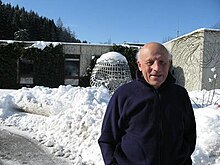Pierre Cartier (mathematician)
Pierre Cartier | |
|---|---|
 | |
| Born | 10 June 1932 |
| Nationality | France |
| Alma mater | University of Paris |
| Known for | Cartier divisor |
| Awards | Ampere Prize (1979) |
| Scientific career | |
| Fields | Mathematics |
| Institutions | Institut des Hautes Études Scientifiques |
| Doctoral advisor | Henri Cartan André Weil |
| Doctoral students | François Digne Guy Henniart Marc Rosso |
Pierre Emile Cartier (born 10 June 1932) is a mathematician. An associate of the Bourbaki group and at one time a colleague of Alexander Grothendieck, his interests have ranged over algebraic geometry, representation theory, mathematical physics, and category theory.
He studied at the École Normale Supérieure in Paris under Henri Cartan and André Weil.[1] Since his 1958 thesis on algebraic geometry he has worked in a number of fields. He is known for the introduction of the Cartier operator in algebraic geometry in characteristic p, and for work on duality of abelian varieties and on formal groups. He is the eponym of the Cartier divisor.
From 1961 to 1971 he was at Strasbourg. He was awarded the Ampere Prize of the French Academy of Sciences in 1979. In 2012 he became a fellow of the American Mathematical Society.[2]
References
- ^ Pierre Cartier at the Mathematics Genealogy Project
- ^ List of Fellows of the American Mathematical Society, retrieved 2012-11-10.
External links
- Cartier's website at the Institut des Hautes Études Scientifiques, with a photograph, CV, and list of publications
- Issue of Moscow Mathematical Journal dedicated to Pierre Cartier
- http://www-history.mcs.st-and.ac.uk/Biographies/Cartier.html
